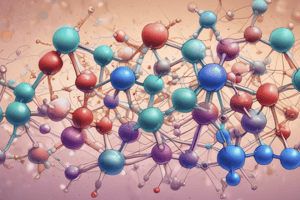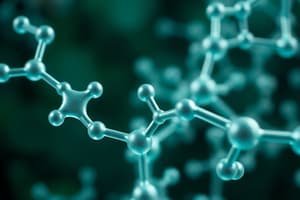Podcast
Questions and Answers
What are some of the most important nitrogen-containing molecules in organisms?
What are some of the most important nitrogen-containing molecules in organisms?
Amino acids
What is the general structure of an amino acid?
What is the general structure of an amino acid?
Amino acids consist of a carboxyl group, an amino group, a hydrogen, and an R-group side chain covalently bonded to a central carbon atom.
What causes the differences in properties between amino acids?
What causes the differences in properties between amino acids?
The chemical nature of the side-chain group
How are amino acids held together?
How are amino acids held together?
Describe a peptide bond.
Describe a peptide bond.
What is the correct way to write the peptide formula?
What is the correct way to write the peptide formula?
How is the amino acid sequence of a peptide conveniently expressed?
How is the amino acid sequence of a peptide conveniently expressed?
What is a peptide called with more than ten amino acids?
What is a peptide called with more than ten amino acids?
What is a peptide called with more than 100 amino acids?
What is a peptide called with more than 100 amino acids?
Where do the other amino acids that our bodies need come from?
Where do the other amino acids that our bodies need come from?
What determines the three-dimensional shape of a protein?
What determines the three-dimensional shape of a protein?
Describe the helix 3D shape of a protein.
Describe the helix 3D shape of a protein.
Describe the pleated sheet 3D shape of a protein.
Describe the pleated sheet 3D shape of a protein.
What is a catalyst?
What is a catalyst?
Explain how enzymes act as biological catalysts.
Explain how enzymes act as biological catalysts.
Flashcards are hidden until you start studying
Study Notes
Amino Acids Overview
- Amino acids are essential nitrogen-containing molecules in living organisms.
- The 20 common amino acids are crucial for various biological processes.
Structure of Amino Acids
- Comprised of a central carbon atom bonded to a carboxyl group, an amino group, a hydrogen atom, and a unique R-group side chain.
Properties of Amino Acids
- Differences in amino acid properties arise from varied R-group side chains.
- Side chains can be nonpolar (aliphatic/aromatic), polar, acidic, or basic.
Peptide Bonds
- Peptide bonds form between the carboxyl group of one amino acid and the amino group of another.
- Each bond results from a condensation reaction, generating a water molecule.
Writing Peptide Formulas
- Peptide formulas are conventionally written with the free amino group on the left and the free carboxyl group on the right.
Amino Acid Sequence
- The sequence of amino acids in a peptide is expressed using three-letter abbreviations (e.g., Asp—Glu—Gly).
- Peptides can be extended indefinitely through condensation polymerization.
Polypeptides and Proteins
- A peptide chain with over ten amino acids is termed a polypeptide.
- Chains exceeding 100 amino acids are classified as proteins, which are vital biomolecules found in skin, hair, nails, and muscles.
Sources of Amino Acids
- Some amino acids are synthesized by the body, while others must be obtained from protein-rich foods such as beans and brown rice.
Protein Structure
- The 3D structure of proteins is influenced by interactions among amino acids within the peptide chains.
- Hydrogen bonds between folded chains contribute to maintaining protein shape.
Helix Structure
- Some peptide chains coil into a regular spiral known as a helix, as observed in myoglobin, which stores oxygen in muscle tissue.
Pleated Sheet Structure
- Peptide chains can also form a pleated sheet configuration by arranging side by side.
Enzymes as Catalysts
- Enzymes, a subset of proteins, serve as biological catalysts, speeding up chemical reactions by lowering activation energy without being consumed in the process.
Fun Fact
- Urease was the first enzyme isolated (by James B. Sumner in 1926) and is involved in breaking down urea, a component of urine.
Studying That Suits You
Use AI to generate personalized quizzes and flashcards to suit your learning preferences.




